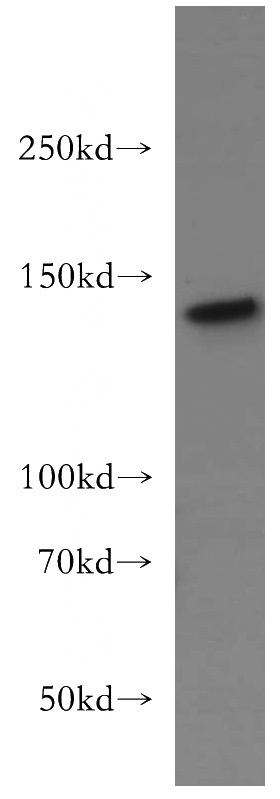-
Product Name
INPP5D antibody
- Documents
-
Description
INPP5D Rabbit Polyclonal antibody. Positive WB detected in Jurkat cells. Observed molecular weight by Western-blot: 145kd
-
Tested applications
ELISA, WB
-
Species reactivity
human, mouse, rat; other species not tested.
-
Alternative names
INPP5D antibody; SHIP 1 antibody; hp51CN antibody; SHIP1 antibody; SIP 145 antibody
-
Isotype
Rabbit IgG
-
Preparation
This antibody was obtained by immunization of Peptide (Accession Number: NM_001017915). Purification method: Antigen affinity purified.
-
Clonality
Polyclonal
-
Formulation
PBS with 0.02% sodium azide and 50% glycerol pH 7.3.
-
Storage instructions
Store at -20℃. DO NOT ALIQUOT
-
Applications
Recommended Dilution:
WB: 1:200-1:2000
-
Validations

Jurkat cells were subjected to SDS PAGE followed by western blot with Catalog No:111843(INPP5D antibody) at dilution of 1:300
-
Background
INPP5D, also named as SHIP, SHIP1, SIP-145 and hp51CN, belongs to the inositol-1,4,5-trisphosphate 5-phosphatase family. INPP5D is phosphatidylinositol (PtdIns) phosphatase that specifically hydrolyzes the 5-phosphate of phosphatidylinositol-3,4,5-trisphosphate (PtdIns(3,4,5)P3) to produce PtdIns(3,4)P2, thereby negatively regulating the PI3K (phosphoinositide 3-kinase) pathways. INPP5D acts as a negative regulator of B-cell antigen receptor signaling. It mediates signaling from the FC-gamma-RIIB receptor (FCGR2B), playing a central role in terminating signal transduction from activating immune/hematopoietic cell receptor systems. INPP5D acts as a negative regulator of myeloid cell proliferation/survival and chemotaxis, mast cell degranulation, immune cells homeostasis, integrin alpha-IIb/beta-3 signaling in platelets and JNK signaling in B-cells. INPP5D regulates proliferation of osteoclast precursors, macrophage programming, phagocytosis and activation and is required for endotoxin tolerance. It is involved in the control of cell-cell junctions, CD32a signaling in neutrophils and modulation of EGF-induced phospholipase C activity. It is a key regulator of neutrophil migration, by governing the formation of the leading edge and polarization required for chemotaxis. It modulates FCGR3/CD16-mediated cytotoxicity in NK cells. It mediates the activin/TGF-beta-induced apoptosis through its Smad-dependent expression. INPP5D may also hydrolyze PtdIns(1,3,4,5)P4, and could thus affect the levels of the higher inositol polyphosphates like InsP6.
-
References
- Hagberg N, Theorell J, Schlums H, Eloranta ML, Bryceson YT, Rönnblom L. Systemic lupus erythematosus immune complexes increase the expression of SLAM family members CD319 (CRACC) and CD229 (LY-9) on plasmacytoid dendritic cells and CD319 on CD56(dim) NK cells. Journal of immunology (Baltimore, Md. : 1950). 191(6):2989-98. 2013.
Related Products / Services
Please note: All products are "FOR RESEARCH USE ONLY AND ARE NOT INTENDED FOR DIAGNOSTIC OR THERAPEUTIC USE"
